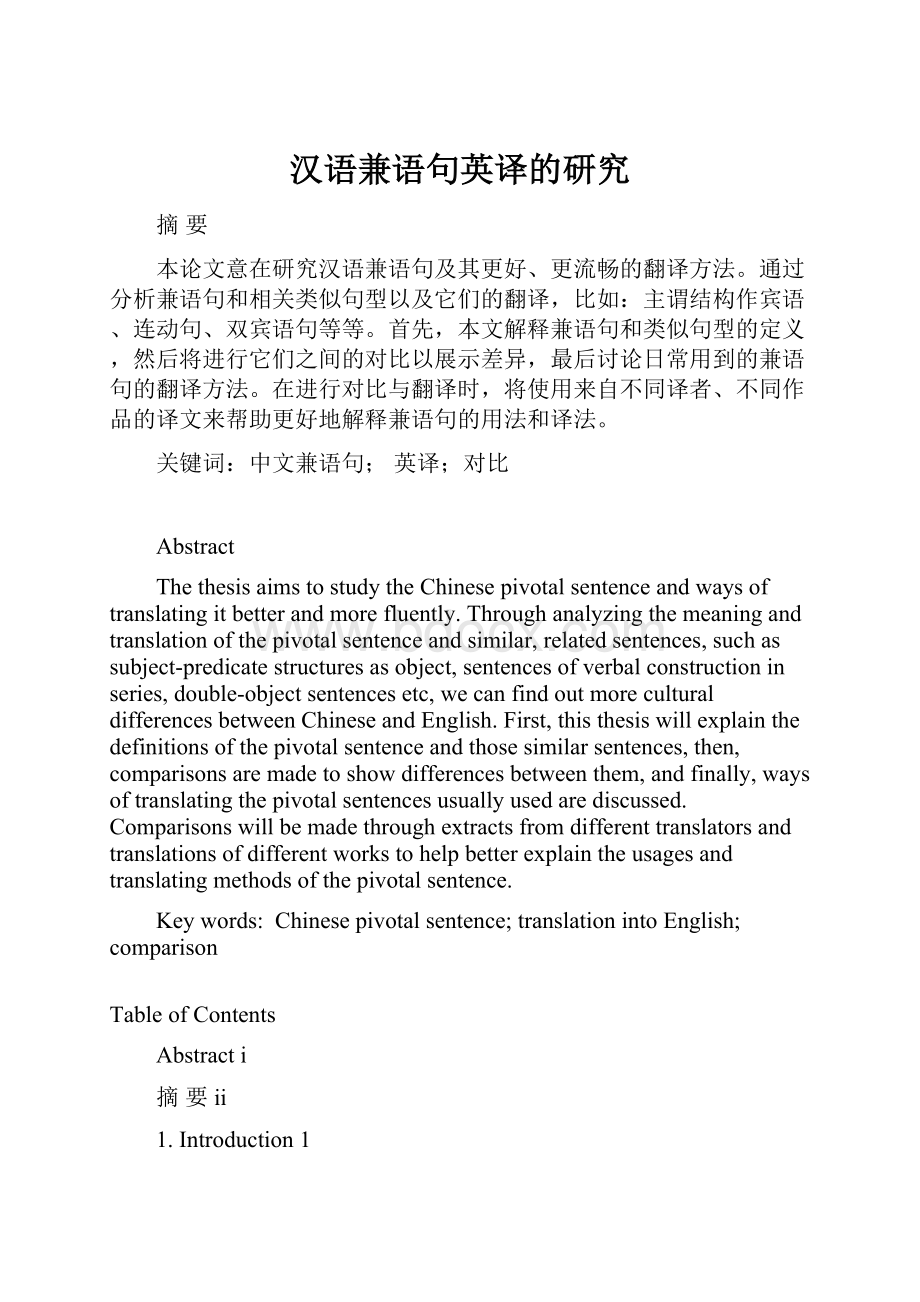汉语兼语句英译的研究.docx
《汉语兼语句英译的研究.docx》由会员分享,可在线阅读,更多相关《汉语兼语句英译的研究.docx(18页珍藏版)》请在冰豆网上搜索。

汉语兼语句英译的研究
摘要
本论文意在研究汉语兼语句及其更好、更流畅的翻译方法。
通过分析兼语句和相关类似句型以及它们的翻译,比如:
主谓结构作宾语、连动句、双宾语句等等。
首先,本文解释兼语句和类似句型的定义,然后将进行它们之间的对比以展示差异,最后讨论日常用到的兼语句的翻译方法。
在进行对比与翻译时,将使用来自不同译者、不同作品的译文来帮助更好地解释兼语句的用法和译法。
关键词:
中文兼语句;英译;对比
Abstract
ThethesisaimstostudytheChinesepivotalsentenceandwaysoftranslatingitbetterandmorefluently.Throughanalyzingthemeaningandtranslationofthepivotalsentenceandsimilar,relatedsentences,suchassubject-predicatestructuresasobject,sentencesofverbalconstructioninseries,double-objectsentencesetc,wecanfindoutmoreculturaldifferencesbetweenChineseandEnglish.First,thisthesiswillexplainthedefinitionsofthepivotalsentenceandthosesimilarsentences,then,comparisonsaremadetoshowdifferencesbetweenthem,andfinally,waysoftranslatingthepivotalsentencesusuallyusedarediscussed.Comparisonswillbemadethroughextractsfromdifferenttranslatorsandtranslationsofdifferentworkstohelpbetterexplaintheusagesandtranslatingmethodsofthepivotalsentence.
Keywords:
Chinesepivotalsentence;translationintoEnglish;comparison
TableofContents
Abstracti
摘要ii
1.Introduction1
1.1Literaturereview1
1.2SignificanceofResearchontheTranslationoftheChineseSimpleSentence1-2
1.3StructureofthisPaper2
2.DefinitionandTypesofthePivotalSentence3
2.1DefinitionoftheChinesePivotalSentence3
2.2TypesofPivotalSentences3
2.2.1ThePre-pivotVerbDenotesRequest,PermissionorCompelling........................................................3
2.2.2ThePre-pivotVerbDenotesEmotionorEvaluation............................................................................4
2.2.3ThePre-pivotVerbDenotesNaming,ChoiceorAppointment............................................................4
2.2.4ThePre-pivotVerbDenotesCauseandEffect.....................................................................................4
2.2.5ThePre-pivotVerbDenotesPossesionorExistence............................................................................4
3.DifferencebetweenthePivotalSentenceandSomeOtherPatterns...........................................................5
3.1DifferencebetweenthePivotalSentenceandaSentencewithSubject-predicateStructureasObject....5-6
3.2DifferencebetweenthePivotalSentenceandaSentencewithVerbalConstructioninSeries....................6
3.3DifferencebetweenthePivotalSentenceandtheDouble-objectSentence.................................................6
4.VariousWaysoftranslatingthePivotalSentence..............................................................................7
4.1TranslationofaPivotalSentenceWhosePre-pivotVerbDenotesRequest,OrderorPermission………...7
4.2TranslationofaPivotalSentenceWhosePre-pivotVerbDenotesEmotionorEvaluation…………..….7-8
4.3TranslationofaPivotalSentenceWhosePre-pivotVerbDenotesNaming,Choiceorappointment…..8-9
4.4TranslationofaPivotalSentenceWhosePre-pivotVerbDenotesCauseandEffect………………….....9
4.5TranslationofaPivotalSentenceWhosePre-pivotVerbDenotesPossessionorExistence………….9-10
5.Conclusion11
6.References12
5.Acknowledgement13
1.Introduction
1.1LiteratureReview
Nowadays,ChinaisgrowingstrongerasourgovernmentcarriedoutmanymacroeconomicpoliciestofacilitatehundredsofthousandsofChinese’livingconditionaswellastheglobalizationnarrowinggapbetweencountries.TheworldiswitnessingtheincreaseofChina’snationalpower,withtheresultthatChineseiswidelyheardallovertheworld,andmoreandmoreforeignersareeagertolearnChineseintheirsparetime.After5000years’inheritance,changeanddevelopment,Chinesepreservedtheessenceofourlonghistoryandabsorbedstrengthsofotherlanguages.ForusChinese,carryingforwardourlanguageandhavingabetterunderstandingofChinese-Englishtranslationarequitecrucial.Thepivotalsentence,commonlyusedbyeverybodyandeveryday,playsanimportantroleinourdailycommunicationevenafterlonghistoryofvicissitude.
TherearealargeamountofpeoplebothfromChinaandabroadcontributealotintheareaofstudyingtranslationbetweenChineseandEnglish,yetintheareaoftranslatingChinesepivotalsentence,thefigureisquitesmall.Someresearchershavewrittenanumberofshortarticlesaboutthetranslationofthepivotalsentences,theytried,firstly,totellthereadersasimplefactthatwhatisChinesepivotalsentence,howitisstructured,andhowitcanbetranslatedaccordingtocharactersofitscertaintypes,forexample,thatpublishedinDecember1982,thenrepublishedagainin2003,bookanalyzingtranslationwhichwaswrittenbyseveralscholarsinXi’antriedtoexplorethetranslationoftheChinesepivotalsentenceintoEnglish,yetthewaysoftranslatingonlyaccountedfortwopages;publishinghisshortthesisinJournalofSoutheastGuizhouNationalTeacher’sCollegein2000,teacherPengSixiangclassifiedandexplainedwaysoftranslatingtheChinesepivotalsentenceinhisownwaybythehelpsoffewrelevantmaterialsinChinese,EnglishandevenJapanese.However,suchliteraturesarescantyandlimitedbecausetherearetoofewscholarsdevotedtothestudyoftranslatingtheChinesepivotalsentenceintoEnglish,itishardtofindoutsomeusefulmaterials,ifany,theyusuallyappearingrammarbookscoveringonlyafewpagesoronepage,evenafewlines,letaloneanyauthoritativeworksathomeorabroad.
Whatmyworkfocusesoninthisareaissummarizedfromrelevantknowledge,helpingtoextendthevalueofstudy,andwhat’smoresignificant,tocallformoreattentiontothisareafromthepublic.
1.2SignificanceofResearchontheTranslationoftheChineseSimpleSentence
Chinesecivilizationisextensiveandprofound;everysentencerepresentsthecombinationofmodernandculturaltradition.Throughcommunicationinpolitics,commerceandculture,Chinahaslearntalotfromothercountries,includinglanguage.Inordertopromotesocialandhumanprogress,Chineseshouldbebetterunderstoodbyothercountries.Asthebasiccommunicationtool,Englishsimplesentencesareclassifiedintofivetypes:
SV(subject+verb),SVC(subject+verb+complement),SVO(subject+verb+object),SVOO(subject+verb+indirectobject+directobject)andSVOC(subject+verb+object+objectcomplement).WeusethemfrequentlywhenwecommunicateinEnglish.However,itisabigproblemtotranslateeveryChinesesentenceintoEnglishsothatcommunicationmaybeeasier,becauseChinesesentencescannotbetwistedintoEnglishdirectly,theyneedsomechanges.Forexample,
(1)用英语怎么说?
Thetranslationcannotbe:
“HowtouseEnglishtosay?
”Thecorrecttranslationshouldbe“HowdoyousayitinEnglish?
”becausetheformerisn’tcorrectEnglish,buttypicalChinglishimposingtheChinesesentencepatternonEnglish.
(2)Itisawisemanthatnevermakesmistakes.
MostChinesewilltranslatethissentencelikethis:
聪明的人是不会犯错误的.However,thecorrecttranslationofthissentenceis:
再聪明的人也会犯错误or智者千虑必有一失.Here,thereasonwhywemakemistakesintranslatingitisnotonlyourlackofknowledgeinEnglishculturebutalsowedon’tknowwellaboutthestructureofgrammar.
Theabovesentencesaresimpleone,butcomplexsentencesarebasedonsimplesentences.Ifoneisunabletotranslatesimplesentences,translationofcomplexoneswillbeoutofthequestion.Therefore,thetranslationofthesimplesentenceisofgreatvalue.
1.3StructureofthisPaper
Thispaperconsistsoffiveparts.Thefirstpartisanintroduction,whichmakesareviewoftheliteratureonthestudyoftheChinesepivotalsentenceanddiscussesthesignificanceofthiskindofstudy.Thesecondpartdealswiththedefinitionofthepivotalsentenceanditsclassification.Thethirdpartdistinguishesthedifferencesbetweenthepivotalsentenceandsomeotherpatternthatlooklikeitonthesurface.Then,wecometotheparamountpart-thetranslationofthepivotalsentence,wherethetranslationofitsfivesub-typesisdiscussed,illustratedwithdaily-usedsentencesandsentencesfromtranslationsofbooksbyfamoustranslators.Attheendistheconclusion.
2.DefinitionandTypesofthePivotalSentence
2.1DefinitionoftheChinesePivotalSentence
ThepredicateoftheChinesepivotalsentenceconsistsofaverb-objectphraseandsubject-predicatephrase,butthesetwophrasesarenotindependentofeachother,butinterconnectedtoeachother,thatis,theobjectoftheverb-objectphraseisatthesametimethesubjectofthesubject-predicatephrase.Forexample:
你请他来(Youinvitehimtocome),inthisChinesesentence,theobjectof“请”is“他”,andontheotherhand,“他”alsoservesassubjectof“来”.ThiskindofChinesesentenceisnamedthepivotalsentence,and“他”isthepivot.ThisEnglishnamecomesfromthefactthatthesegmentthatservesbothastheobjectofthefirstverbandthesubjectofthesecondverbislikeapivot—ashortshaftaroundwhichsomethingturns.
What’smore,thesecondverbinthepivotalsentencedoesnothaveanysubject-predicaterelationshipwiththesentence’ssubject,thatis,thetwoverbsinapivotalsentence’spredicatedonotsharethesamesubject.Thepredicateofapivotalsentence’ssubject-predicatephrasecanbeadjective,subject-predicatephrase,nounor,mostly,verb.
Forexample:
(3)这个消息使我很高兴。
Thisnewsmademeveryhappy.
Thepivotis“我”,and“高兴”isitspredicate;
(4)祝你身体健康。
Wishyouthebestofhealth.
Here,thepivotis“你”,anditspredicateisthesubject-predicatephrase“身体健康”.
2.2TypesofPivotalSentences
Accordingtothedifferentkindsthefirstverbofthepivotalsentenc